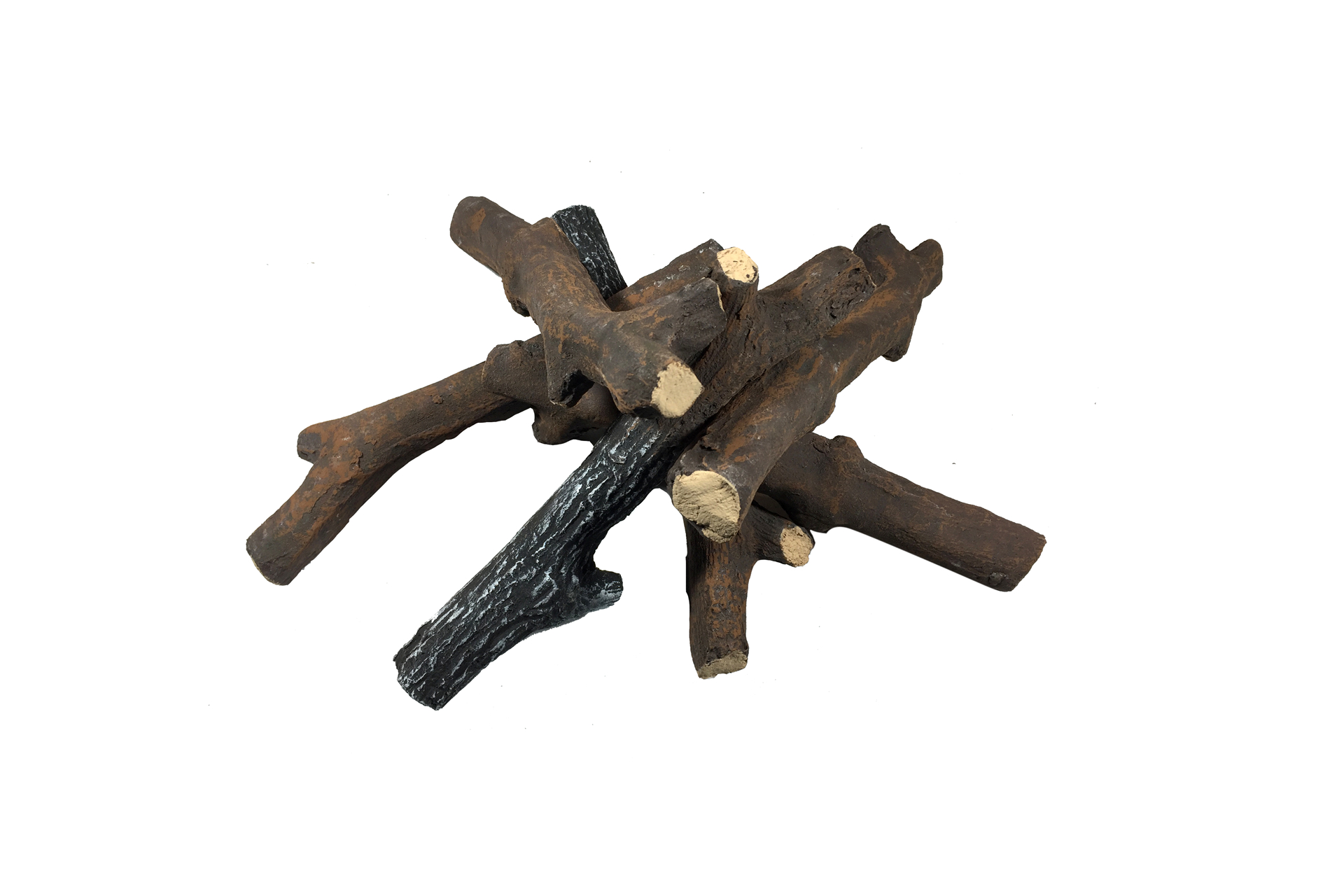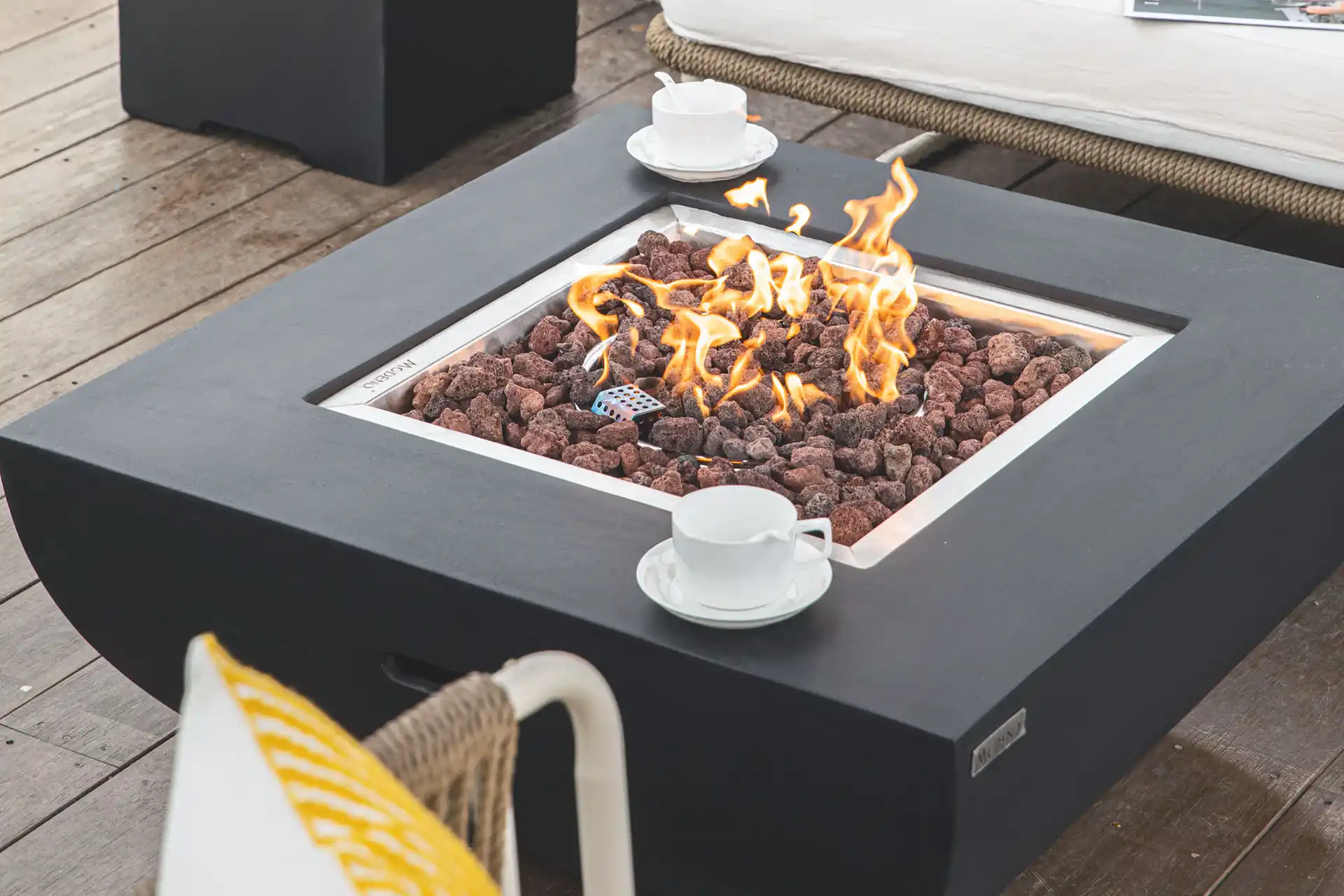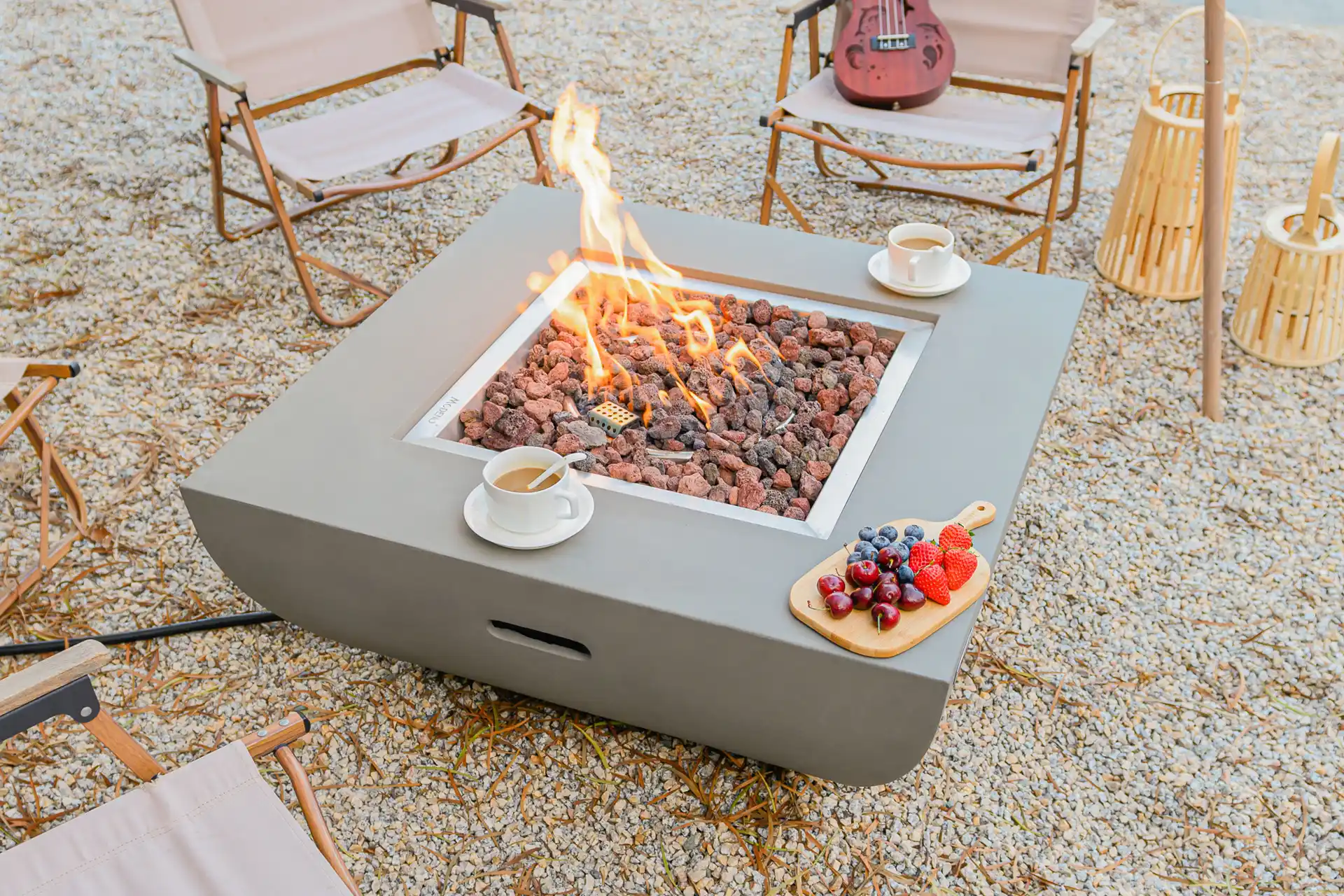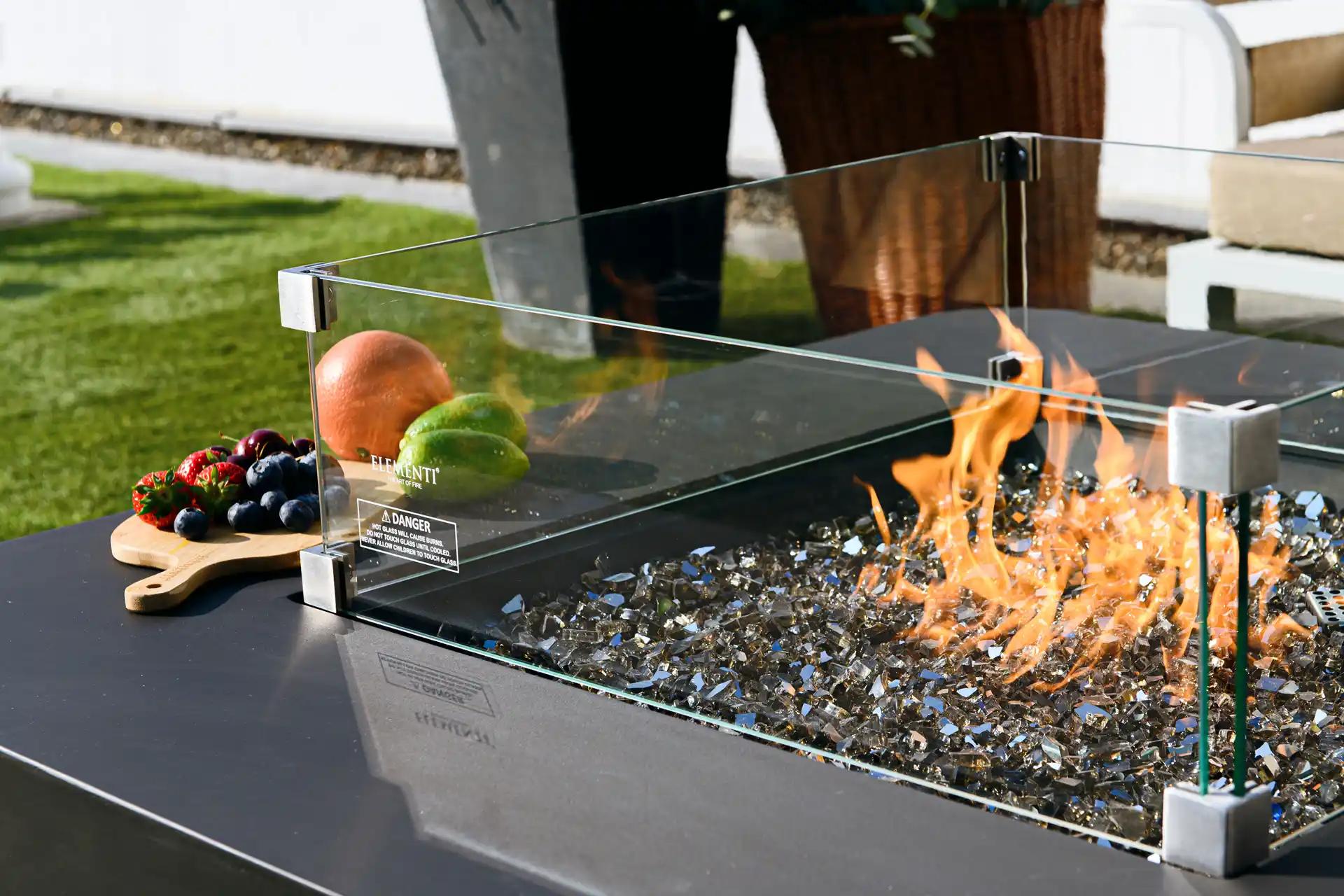Filling media (fire media) determine the flame pattern, heat emission and appearance of your gas fireplace. This guide explains in practical terms how lava stone and fire glass work, how to use them correctly and how to maintain them safely – for an individual, long-lasting result on the terrace, patio or next to furniture made of GF concrete (glass fiber reinforced concrete).



1 Why does a gas fireplace need filling media?
Without filling material, the flame is concentrated on individual points. A suitable medium distributes the gas more evenly, stabilizes the flame pattern and at the same time covers the burner for a harmonious look. Common media are lava stone, fire glass and ceramic wood (ceramic logs).
2 How much filling material is needed?
As a rule of thumb, a layer of approx. 2.5 cm (1 inch) above the burner at normal line pressure is sufficient. Layers that are too thick impede the gas flow; layers that are too thin produce unsteady flames.
Note on nozzle burners (e.g. torpedo/bullet): The nozzles must remain visible or be flush with the medium. Only cover the pipe segment, not the nozzle openings.
3 Lava rock (Lava Rock)
3.1 Features & benefits
Lava stone is a natural, porous volcanic rock. The pores are formed when magma solidifies and make the material light, heat-resistant and durable. It is low-maintenance and is ideal as a base under more decorative media.
- Very high temperature resistance, can be used permanently outdoors
- Natural, soft flame pattern thanks to good gas distribution
- Cost-efficient – popular as a base layer
Optical consistency: Size, shape and color may vary depending on the batch. For a uniform appearance, we recommend buying sufficient quantities once.
3.2 Layering lava stone correctly
- Read the manufacturer’s instructions and check the required quantity.
- Wear sturdy gloves.
- Pour out the lava stone in advance and remove dust/breakage (prevents clogged burner openings).
- Smaller pieces at the bottom, larger pieces at the top – distribute evenly.
3.3 Lava stone as a base layer
Fill the pool area up to approx. 3/4 of the height with lava stone and add a decorative top layer on top – e.g. fire glass or decorative pebbles – for a high-quality, multi-layered appearance on a moderate budget.
3.4 Dealing with moisture
Lava stone is hygroscopic. Moist stones can burst open when heated up quickly.
- Start in stages: Start with a low flame height for 15-30 minutes (longer if necessary if humidity is high), then gradually increase.
- Protection: Always cover when not in use to keep out rain and condensation.
- Winter storage: If possible, store in a dry place.
- Important: Only cover completely cooled fireplaces – avoid heat damage to covers.
4 Fire Pit Glass
4.1 What is tempered fire glass?
Fire glass is toughened (tempered), colored safety glass. Thermal tempering creates a compressive stress field on the surface – the resistance increases many times over compared to normal glass. Edges are tumbled/polished so that the surface is safe to touch.
- Heat-stable, color and shape-retaining, no melting, no emissions
- High reflection: radiates heat noticeably into the outside space
- Wide color spectrum, elegant, modern look
4.2 Types of fire glass
- Accent (decor): Small, irregular pieces – ideal for adding colorful accents, also as a top layer.
- Reflective (mirror effect): With a reflective surface for intense light reflections – a strong presence during the day and with a flame.
- Smooth (smooth/rounded): Uniform, “pearl-like” shapes with a soft feel – minimalist and modern.
4.3 Reduce costs & optimize optics
Fire glass is of higher quality – and more expensive – than lava stone. Popular solution:
- Hybrid layering: lava stone at the bottom (budget & volume), fire glass at the top (appearance).
- Choice of color with propane: Lava stone can lead to slight soot formation on the glass with propane. Dark glass colors conceal deposits; alternatively, clear glass at the bottom, colored glass at the top – this reduces cleaning effort.
4.4 Cleaning fire glass
- Put on protective gloves and remove the glass completely.
- Move carefully in lukewarm soapy water, then rinse with clear water.
- Spread out on a cloth and allow to dry completely.
- Only then return to the cold, dry fire.
5 Safety & operation
- Filling media are designed for gas fireplaces (natural gas/propane).
- Do not stack any additional materials on the glass top layer.
- Provide at least two ventilation openings on the pool – avoid overheating.
- After switching off, the medium remains hot – only transfer/clean when cold.
- Frequent sooting indicates an incorrect gas/air ratio – have the installation checked.
- Always wear gloves when handling; glass can break if dropped.
- Cover when not in use to minimize moisture, dust and UV exposure.
6 Lava stone vs. fire glass – a direct comparison
| Criterion | Lava stone | Fire glass |
|---|---|---|
| Material | Natural volcanic rock, porous | Tempered, colored safety glass |
| Flame pattern | Gentle, “organic” | Brilliant, highly reflective |
| Heat reflection | Medium | High (reflective surface) |
| Care | Low | Regular cleaning recommended |
| Costs | Lower | Higher |
| Style | Natural, rustic | Modern, luxurious |
| Hybrid use | Ideal as a base layer | Ideal as a top layer |
7 Conclusion
Filling media are more than just decoration: they shape the flame, improve heat emission and define the style of your fireplace. Lava stone scores with naturalness, robustness and budget-friendliness. Fire glass provides maximum brilliance, strong heat reflection and a modern, colorful signature. The combination of base layer (lava stone) and top layer (fire glass) combines the best of both worlds – visually, technically and economically.
8 FAQ – Filling media for gas fireplaces
Why are filling media important in a gas fireplace?
Filling media such as lava stone or fire glass distribute the gas evenly, stabilize the flame pattern and cover the burner. Without a medium, flames appear unsteady and the appearance is inconsistent.
How much filling material should I use?
Rule of thumb: approx. 2.5 cm (1 inch) above the burner. Too thick impedes the gas flow, too thin produces unsteady flames. With jet burners, the nozzles must remain visible or flush.
What is lava stone and what are its advantages?
Lava stone is porous volcanic rock, very heat-resistant and durable. It provides a natural, soft flame pattern, is budget-friendly and ideal as a base layer under decorative media.
What is fire glass and how does it differ from lava stone?
Fire glass is tempered, colored safety glass. It reflects heat, creates a brilliant, modern appearance and offers many colors. It is more expensive than lava stone and should be cleaned regularly.
Can lava stone and fire glass be combined?
Yes, proven: lava stone at the bottom (volume, distribution, cost savings), fire glass at the top (appearance, color, shine). This allows you to combine efficiency with a high-quality appearance.
How do I clean fire glass properly?
- Wear gloves and remove the glass completely.
- Clean in lukewarm soapy water, then rinse thoroughly.
- Allow to dry completely and only reinsert when cold.
What to do with wet lava stone?
First preheat on a low flame for 15-30 minutes (longer if humidity is high) to allow moisture to escape. Cover or store in a dry place when not in use.
Are there any visual/technical differences in the result?
- Lava stone: Natural, gentle flame pattern; medium heat reflection.
- Fire glass: Brilliant reflections, modern look; high heat reflection.
What mistakes should I avoid when filling?
- Do not use normal glass, river pebbles or random stones (risk of explosion).
- Do not cover the nozzles of jet burners.
- Do not fill too high – the gas flow and flame pattern will suffer.
How do I increase safety during operation?
- Provide at least two ventilation openings; keep flammable materials away.
- Never leave burning unattended; only cover/clean when cool.
- If sooting occurs frequently, have the gas/air mixture checked professionally.















